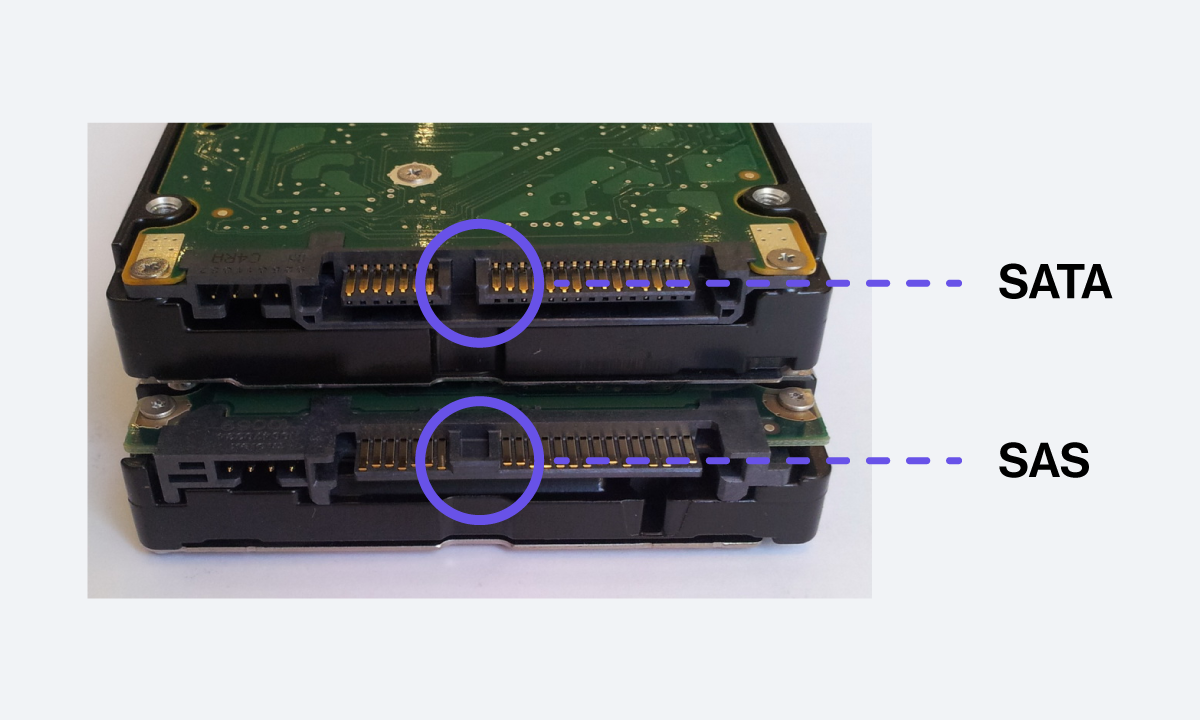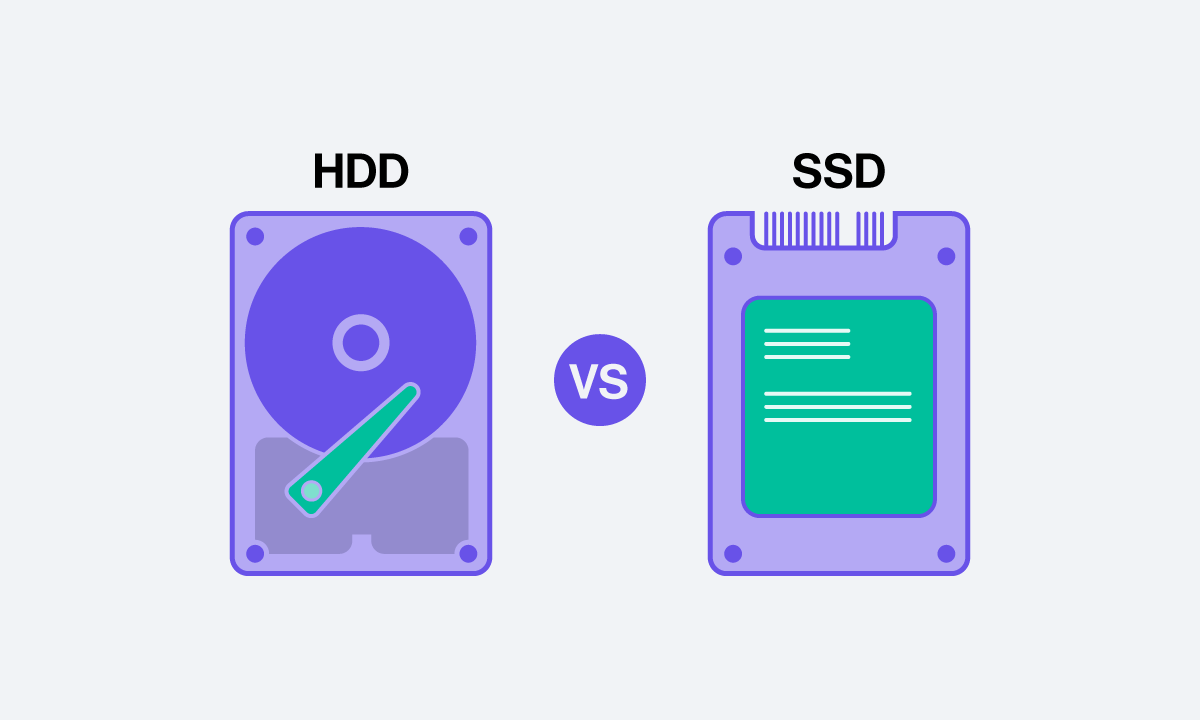What is SATA and SAS?
SATA (Serial Advanced Technology Attachment) and SAS (Serial Attached SCSI) are two common interfaces for connecting storage devices like hard drives and solid-state drives (SSDs) to a computer system. In simple terms, your storage—whether HDD or SSD—holds all the data and files for your workstation.
While they share some infrastructure, the connectors differ:
- SATA drives can be plugged into a SAS connector.
- SAS drives cannot be plugged into a SATA connector due to different keying.
The distinction between the two comes down to three main factors:
- Performance
- Scalability
- Reliability

The Difference Between SATA and SAS
Although SATA and SAS serve the same purpose—connecting storage devices—their differences make them suitable for very different use cases.
Performance and Speed
SAS drives outperform SATA with higher transfer rates (up to 12 Gbps vs. 6 Gbps), lower latency, and faster access times, making them ideal for enterprise environments with data-intensive applications despite their higher cost. SATA drives, however, offer better cost-efficiency and wider compatibility with consumer hardware, making them the practical choice for everyday computing and general storage needs where maximum performance isn't essential.
- SAS: Higher throughput, lower latency, and faster access times. Ideal for databases, virtualization, and data-intensive workloads.
- SATA: Slower overall but sufficient for everyday computing, multimedia, and general storage.
Compatibility
SAS interfaces are backward compatible with SATA drives, meaning that SATA drives can be connected to SAS ports. However, the reverse is not true. SATA interfaces can only support SATA drives and are not compatible with SAS drives.
- SAS: Backward-compatible with SATA drives, allowing SATA devices to connect to SAS ports.
- SATA: Limited to SATA-only drives and cannot support SAS devices.
Scalability
SAS interfaces allow for greater flexibility and scalability, making them ideal for complex storage setups. SAS drives can be daisy-chained, enabling the connection of multiple drives to a single controller. This feature simplifies storage expansion and management.
- SAS: Supports daisy-chaining multiple drives to a single controller, enabling easier enterprise-level storage expansion and management.
- SATA: Works best in simple, standalone setups for personal or small business use.
Cost
SATA drives are generally more cost-effective compared to SAS drives. The affordability of SATA makes it a popular choice for personal computers and consumer-grade devices, whereas SAS drives are more commonly used in enterprise-level environments that require enhanced performance and reliability.
- SAS: More expensive but provides enterprise-grade performance and reliability.
- SATA: More affordable, making it popular in consumer systems and budget-friendly storage solutions.
Use Cases
SATA drives are suitable for everyday computing tasks, including web browsing, multimedia playback, and general file storage. On the other hand, SAS drives excel in scenarios that demand high-speed data access, such as server applications, data centers, and enterprise storage systems.
- SAS: Best for servers, data centers, and mission-critical applications that demand high-speed, always-on access.
- SATA: Suitable for personal computers, backups, and workloads with lighter performance requirements.

How Do I Purchase SATA and SAS?
Many computers include SATA or SAS connectors by default, but if you’re building a custom PC or optimizing a server, you may need to purchase additional drives or connectors separately. Both HDDs and SSDs are available in SATA and SAS formats.
Choosing Between SSD and HDD
- SSD (Solid State Drive): Faster read/write speeds, better performance for demanding workloads, but typically offers less storage capacity at the same price point.
- HDD (Hard Disk Drive): Larger storage capacity for a lower cost, but slower performance compared to SSDs.
For most performance-focused applications, SSD is recommended. HDDs are better for bulk storage at a budget.
Where to Buy
You can browse options directly from our store:
Filters allow you to narrow down by SSD vs. HDD, capacity, and other specifications to match your needs.
Pricing and Platform Support
- SAS: More expensive, designed for servers and process-heavy applications. Not widely supported on most consumer or even workstation motherboards since it’s a specialized protocol.
- SATA: More affordable, widely supported, and well-suited for desktops and home workstations.
Other Frequently Asked Questions About SATA & SAS
How many pins does a SATA connector have?
- SATA data cable: 7 pins for data transfer.
- SATA power cable: 15 pins for power delivery.
How many pins does a SAS connector have?
A single-lane SAS data connector also uses 7 pins, just like SATA. However, SAS supports multiple connector standards (e.g., SFF-8482, SFF-8087), which may include additional pins for power and dual-port functionality.
What is the maximum data transfer speed of SATA vs SAS?
- SATA III: Up to 6 Gb/s (750 MB/s) for consumer SSDs and HDDs.
- SAS: Commonly 12 Gb/s for modern drives, with dual-lane SAS supporting higher throughput in enterprise systems.
- Key takeaway: SAS generally offers higher speeds and lower latency, making it better for server and enterprise workloads.
Can I mix SATA and SAS drives in the same system?
- Yes, but with limitations. You can run SATA drives on a SAS controller, but mixing SAS and SATA on a SATA-only controller is not possible.
- SAS is backward-compatible with SATA drives.
- But, SATA cannot support SAS drives.
Are SAS drives more reliable than SATA drives?
- Yes, generally. SAS is ideal for servers and data centers where continuous uptime and drive longevity are critical.
- SAS drives are designed for enterprise workloads, with higher durability and error-checking features.
- SATA drives are reliable and have enterprise options, but physically lack the redundancy and endurance features found in SAS drives.
Do SATA and SAS drives require different cables?
- Yes, SAS controllers can support SATA drives, but the correct cable type is still needed.
- SATA drives: Use standard SATA data cables and SATA power cables.
- SAS drives: Use SAS cables (SFF-8482, SFF-8087, or other SAS variants) that combine data and power or require separate power supply connections.
Are SSDs available in SAS, or only HDDs?
Both SAS SSDs and HDDs are available. Enterprise environments typically deploy:
- SAS SSDs: Used for high-performance workloads requiring low latency and high IOPS, such as databases, virtual environments, and transaction processing.
- SAS HDDs: Commonly used for capacity-oriented storage tiers, backup systems, and archival storage where cost per TB is more important than performance..
Get More Helpful Insights
Still deciding between SATA drives and SAS drives? Our team can help you choose the right storage solution for your build or data center. Explore more comparisons and guides on the SabrePC Blog. Looking to configure your workstation with network-attached storage? Contact us today!


